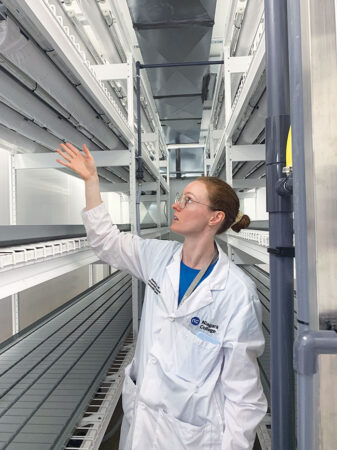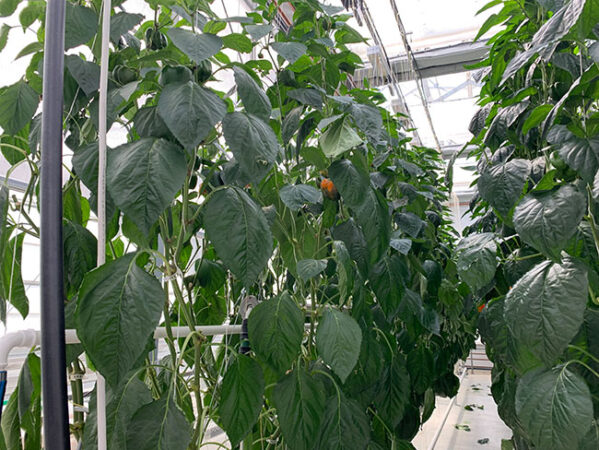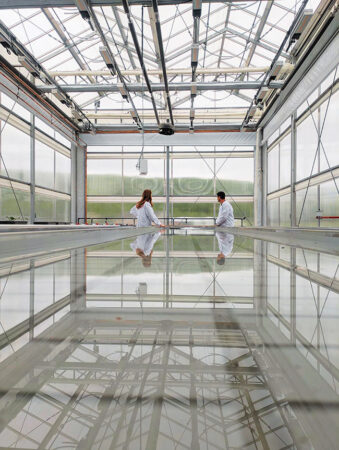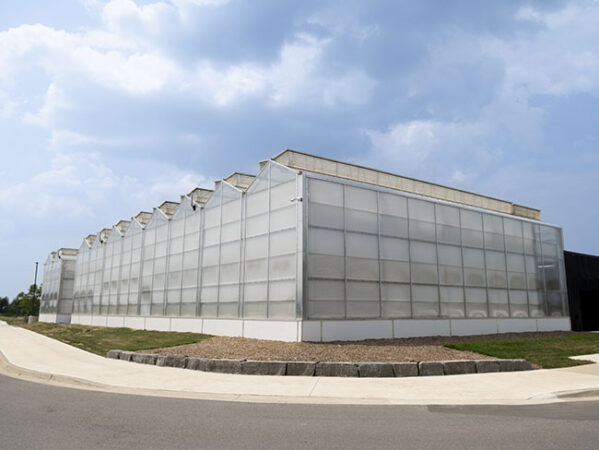
Features
Just the Good News
Research
Q & A: Risk-free innovation
Q & A: HESIC researchers talk new greenhouse at Niagara College and opportunities for industry
October 27, 2025
By Greenhouse Canada
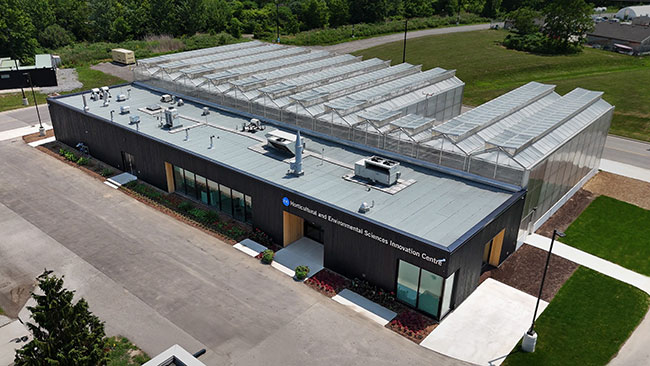 Aerial view of the new research facility at Niagara College’s Horticultural and Environmental Sciences Innovation Centre.
IMAGE courtesy Niagara College
Aerial view of the new research facility at Niagara College’s Horticultural and Environmental Sciences Innovation Centre.
IMAGE courtesy Niagara College Greenhouse Canada recently had the opportunity to tour Niagara College’s Horticultural and Environmental Sciences Innovation Centre (HESIC)’s new greenhouse research facility.
We sat down with research lead Ashley Paling and HESIC research facilities manager, Scott Golem, to learn how this brand new facility is designed to help growers reduce risk, strengthen resilience, and drive innovation across Canada’s greenhouse sector.
What follows is a snapshot of our conversation, condensed and edited for clarity.
This conversation has also been recorded as a video podcast, which can be accessed here.
1. Can you describe the new facility? What are some of the key design features and technologies that have been incorporated?
Scott Golem: The new HESIC research greenhouse at Niagara College is designed with flexibility and industry relevance in mind. It features five individually controlled research bays, each approximately 130 square metres, equipped with independent systems for temperature, humidity, CO2, irrigation, and lighting. Some bays use spectrum-adjustable LED lighting, while one bay remains outfitted with high-pressure sodium (HPS) lighting to reflect the realities of many commercial greenhouses still using legacy systems. Each bay allows us to replicate commercial-scale conditions on a research scale, so the results from our trials are directly applicable to real-world production.
The facility supports a wide range of growing systems. One bay is focused on hydroponics and includes ebb and flood tables capable of running up to four different nutrient trials simultaneously, as well as two nutrient film technique (NFT) systems. We’ve also integrated Phenospex DroughtSpotter scales to run drought stress trials. Another bay is dedicated to high-wire crops such as peppers, cucumbers, and tomatoes. We’re in the process of licensing one bay for cannabis production under Health Canada regulations, which will allow us to conduct specialized cannabis trials in a compliant environment.
The remaining bays are equipped with expanded metal mesh benches, providing a flexible setup suitable for a variety of crops including floriculture, leafy greens, herbs, and vegetables, making them ideal for multi-purpose trials and quick adaptations based on industry needs.
Beyond the greenhouse bays, we’ve incorporated a vertical grow room with approximately 35 square-metres of production space spread across six rack levels in two separate systems.
This setup supports research into vertical farming and controlled environment agriculture. Supporting all of this is our analytical lab and postharvest labs, which will enable us to conduct in-house quality assessments, including tests for colour, texture, flavour, yield, and nutritional content, across a wide range of horticultural crops.
2. How does this facility differ from other research greenhouses in Canada in terms of equipment, environmental control, or capabilities?
Ashley Paling: Canada already has a great ecosystem of research centres, specifically in Ontario, so we’re really honoured to see ourselves as a valuable addition to that existing network. Where we’re unique at HESIC is how we’re structured to serve businesses and ultimately growers.
As a newly designated Technology Access Centre (TAC), our mandate is to help businesses validate and develop their horticultural innovations and technologies, moving those products towards commercialization. HESIC provides access to leading-edge technology, equipment, and expertise, which we make accessible to clients of all sizes, from small- and medium-size enterprises to larger businesses and also commercial growers.
A few things set us apart:
- Accessibility and responsiveness: Because of our scale, we can move quickly to design custom projects and adapt to industry needs.
- No intellectual property restrictions: We don’t keep any intellectual property (IP) related to the project work we do. Results and any IP generated belong to our clients, making collaboration straightforward.
- Student engagement: Our projects involve students who work alongside clients and our research team. It brings fresh perspectives, builds the next generation of talent, and provides clients with motivated hands on the ground.
- Range of systems under one roof: From vertical farming and hydroponics to conventional greenhouse production, we can test innovations across different controlled environment models in one location.
- Third-party validation: We specialize in validation and development of new innovations in controlled environment agriculture.
- Dedicated research team: Our team of experts is completed focused on conducting research projects in the horticultural space with clients.
We see our role as being an agile, industry-focused service provider who complements the work of other research centres in Canada.
3. You’ve mentioned some of new technologies and tools at the facility. Can you explain how these instruments will give growers insights they wouldn’t typically have access to in their own operations?
SG: One of the most exciting things in my mind is the Phenospex TraitFinder. It is basically a plant phenotyping camera. It works on multi-spectral wavelengths to take pictures of plants. It 3D models each plant as it grows and it allows us to see things like nutrient deficiencies or early senescence before it shows up for human eyes to see. [It’s] a very strong tool for when we look at performance of different soil amendments, fertilizers, and different types of media, along with other ways of growing, where we can really start to see what’s happening inside the plant. Another really impressive one is the Phenospex DroughtSpotter scales. These allow us to precision irrigate individual plants to do drought stress tolerance tests. We can incorporate this into projects to see the impact of innovations. We can really start to see the capabilities with these pieces of equipment; how do we maximize water and fertilizer efficiency without being detrimental to the plant.
Another one we have is the Hoogendoorn Aquabalance, which is a scale for growing in highwire rockwool slabs. It allows [for] precision irrigation to, again, save on irrigation water and fertilizer, and ensures healthy growth with efficient resource use. We incorporate the use of this into projects, to see how an innovation is impacting irrigation. We also have an analytical lab and a postharvest lab which have a wide range of capabilities. We have equipment to measure the impact of client innovations on everything from plant size, biodensity, nutrient analysis, pigment content, and sugar content, in addition to a wide variety of genomics equipment. Whatever clients are looking for or whatever new products they would like us to evaluate, we probably have the ability to run those tests, tailor a project to their needs and give very accurate results.
4. With vertical and hybrid production models included under one roof, how do you see crossover opportunities between traditional greenhouse production and vertical farming research?
AP: We tried to aim for having as much adaptability and flexibility as possible in one centre. Our main goal [was] to make sure that we can serve as many clients and their research needs as possible, so we incorporated as many different growing systems as we were able to into the design. Our area of focus as a TAC is specifically in controlled environment agriculture research and in working with clients to evaluate their innovations in that space, which includes both traditional production and vertical growing. Something we’ve seen in agriculture, horticulture and greenhouse spaces is a trend of field crops moving indoors because of weather patterns and land usage over the years. A great example of that is peppers, tomatoes, and cucumbers: a majority of those are grown in Ontario greenhouses right now, and that wasn’t always the case. We’ve also seen within the last 10-15 years, [a] trend of more crops transitioning from greenhouse growing to specifically vertical growing environments. This is a more recent technology and it’s still an evolving field, which means there’s lots of opportunity to work with clients on research projects.
Something important to consider is that vertical grow facility rentals come at a very high cost, so having this space available for clients to test out new ideas means that we can take away that risk of that initial investment for them. In addition, many clients may have innovations in the vertical grow space but may never have their own facilities and need a space where their products can be evaluated.
We have that pre-existing infrastructure to take the risk out of innovation and just focus on their product, its performance and the actual questions that they want answered.
5. What kind of applied research projects will growers/industry be able to follow or participate in?
SG:We focus on applied research that has direct relevance to the horticultural industry and commercial operations. Projects might include:
- Variety trials for vegetables and specialty crops;
- Cannabis-related trials with our soon-to-be licensed cannabis bay, vertical grow room, and labs;
- Technology evaluations, such as new lighting systems, substrates, or automation tools;
- Soil and nutrient studies, including amendments like composts, biofertilizers, rock dusts, and fertilizers;
- Pest management strategies and products, including biocontrols, pesticides, and other integrated pest management strategies for specific crops;
- Crop quality testing, from fruit texture and nutrition, quality and sweetness, to shelf life;
- Sustainability initiatives, such as waste reuse or circular economy projects.
Because of our TAC designation, we’re committed to working directly with clients to answer practical questions, test innovations and reduce risk around adopting new practices.
6. What role will industry stakeholders play in setting research priorities for the greenhouse?
AP: Clients are at the centre of our research program. We build projects in response to their needs, whether that means testing a new input or innovation, validating a product, or helping troubleshoot production challenges. Our advisory connections, industry consultations, and direct partnerships ensure that we’re not just doing research for research’s sake, but tackling real-world challenges that matter to clients, growers and the industry today. We can help with connections for acquiring funding to help offset the costs of our services, Intellectual Property Ontario (IPON), expertise on trial design and interpretation, and delivering industry applicable results.
7. Looking ahead, what do you see as the biggest challenges and opportunities for Canadian greenhouse growers that this facility could help address?
AP: It’s important to focus on current challenges, but it’s also crucial to look ahead [at] what’s coming down the pipeline. We can’t see every single challenge that’s coming our way, but there are some trends and common themes in the industry that I think we can help clients with:
- Sustainability and resource use: Evaluating innovations with the goal to reduce inputs, recycle waste streams, and maintain profitability under tighter environmental standards.
- Crop diversification and innovation: Innovations that address pathogen resistance, climate and temperature adaptation, expanding beyond traditional crops into high-value or specialty crops that can make operations more resilient.
- Risk reduction: Providing an independent space where clients can work with us to validate and further develop products and practices before scaling up in their own operations or moving to commercialization.
There’s definitely some broad themes I think our facility is flexible enough to be able to address,[and] we can take that risk out of asking questions and really focus on providing the answers.
Specs at a Glance
The new HESIC research facility is equipped with:
Five individually controlled research bays
- Each 130m² in size (6m gutter height, 8m width)
- Hoogendoorn IIVO systems
- Bays with spectrum adjustable LED and HPS lights
CONVIRON GEN 2000 growth chamber
- 5m² growing space
- Tissue Culture kit
- Short height and tall height kit
Vertical Grow Room
- 44m² total, 35m² of growing space
- Hoogendoorn controls for room with HVAC for cooling/temperature control
- Philips LED lights
Equipment of note
- Phenospex Traitfinder and DroughtSpotter scales
- Hoogendoorn Aquabalance
- A variety of LICOR, Apogee, Thermo Fisher Scientific, and other relevant pieces of equipment
- Two laboratories: analytical and postharvest with relevant instruments to plant growth and postharvest quality analysis
For more information on HESIC and Niagara College, or to connect with the HESIC team about possible collaboration, visit ncinnovation.ca, or contact our Manager of Business Development, David DiPietro at ddipietro@niagaracollege.ca.
